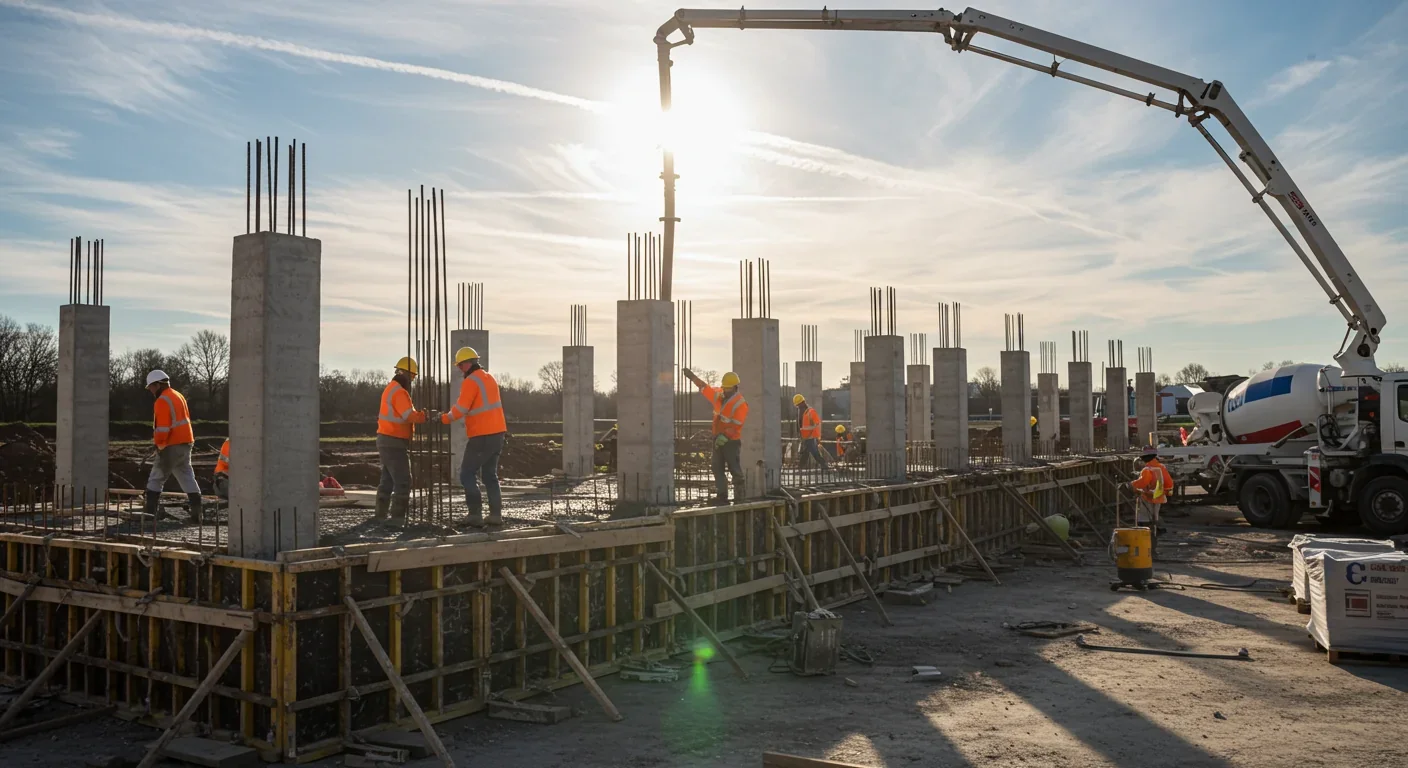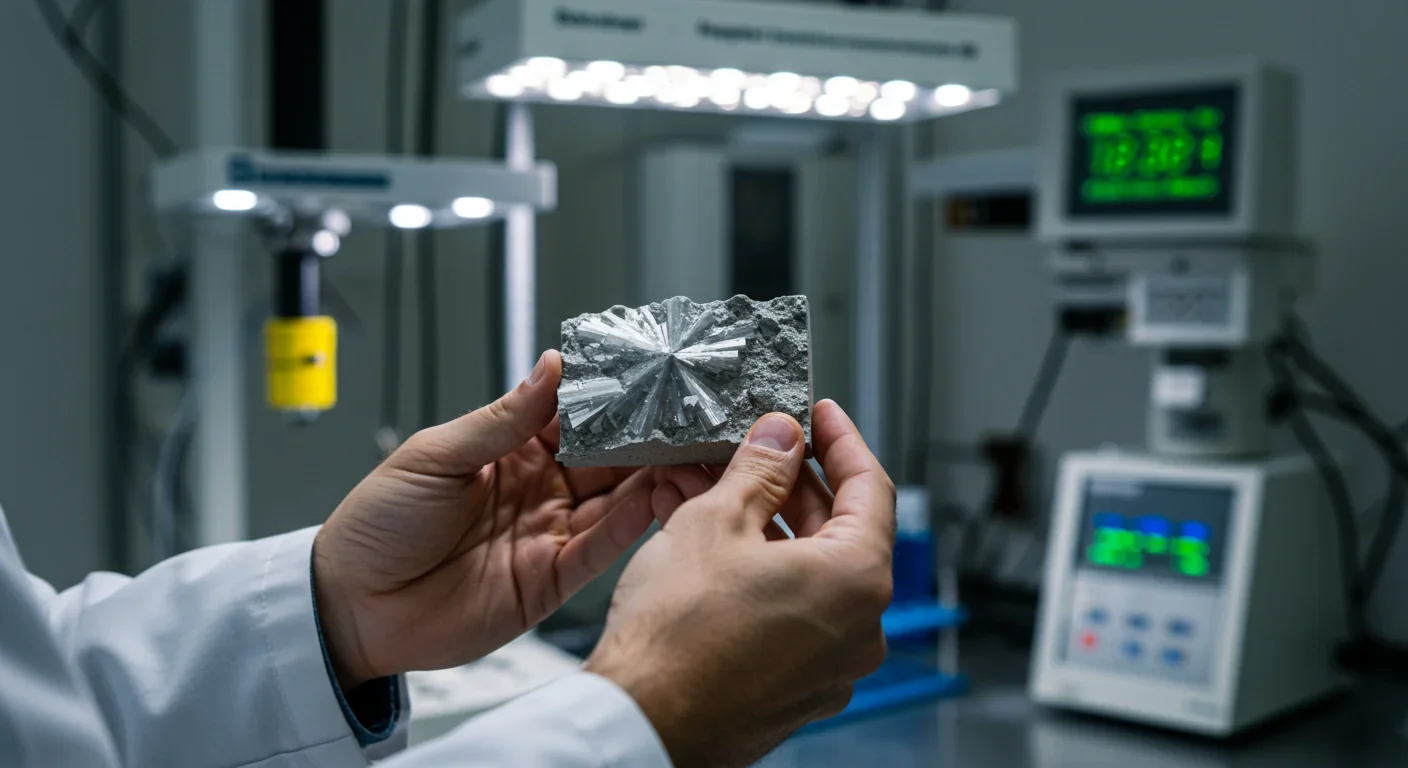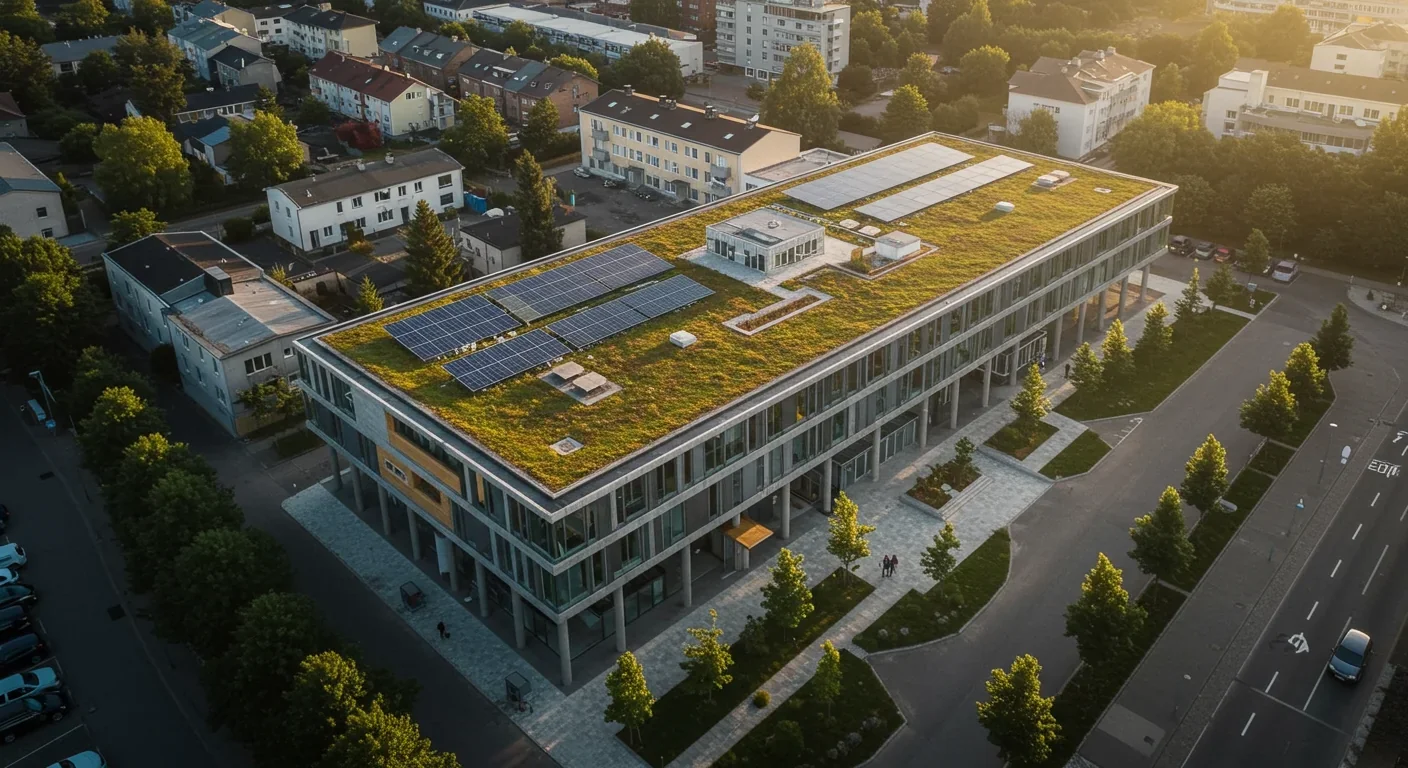Digital Pollution Tax: Can It Save Data Centers?

TL;DR: Carbon-negative concrete technologies are transforming construction by absorbing CO2 instead of emitting it. With 9.5 million truckloads already delivered and multiple pathways from CO2 injection to geopolymers, the industry is proving large-scale decarbonization is achievable now.

What if the buildings around you could actually absorb the carbon dioxide that's choking our planet? That question isn't hypothetical anymore. Right now, construction crews across three continents are pouring concrete that does exactly that, locking away CO2 molecule by molecule. This isn't some distant promise or lab experiment—over 9.5 million truckloads of carbon-mineralized concrete have already been delivered, with 2 million of those in the past year alone.
The timing couldn't be more urgent. Cement production currently pumps out somewhere between 4-8% of all global CO2 emissions, making the industry one of the planet's third-largest carbon culprits. If cement were a country, it would rank right behind China and the United States in greenhouse gas emissions. But here's the twist: the very process causing the problem holds the key to fixing it.
Carbon-negative concrete flips the script on how we think about construction materials. Traditional concrete production heats limestone to 1,400°C in massive kilns, releasing enormous quantities of CO2 both from burning fuel and from the chemical transformation of limestone itself. Every tonne of cement manufactured spits out roughly 900 kg of CO2, accounting for about 88% of the emissions in your average concrete mix.
Carbon-negative concrete, by contrast, pulls CO2 from the atmosphere or industrial waste streams and locks it inside the material itself through a process called mineralization. When CO2 reacts with calcium compounds in concrete, it forms solid calcium carbonate—limestone, essentially—that's permanently trapped in the structure. The same chemistry that creates stalactites in caves happens right in the mixing truck.
The science isn't new, but the industrial-scale application is. Companies like CarbonCure have retrofitted hundreds of concrete plants worldwide to inject captured CO2 directly into fresh concrete during mixing. The CO2 gets added like any other admixture, enabling producers to use less cement without compromising strength. In fact, early studies suggest the injected CO2 can actually boost compressive strength while cutting the carbon footprint by roughly 4.6%.
Several distinct pathways exist for creating carbon-negative concrete, each with its own chemistry and carbon math.
CO2 injection systems represent the most commercially mature approach. These retrofit kits bolt onto existing ready-mix plants and pump precisely measured amounts of CO2 into concrete during batching. The technology works with standard cement types and supplementary cementitious materials like fly ash or slag. A typical CarbonCure mix uses 75% Type I/II cement and 25% Class C fly ash, with CO2 mineralization allowing for reduced cement content while maintaining target strength.
Geopolymer concretes skip traditional cement altogether. Instead of limestone cooked at extreme temperatures, geopolymers use industrial byproducts like fly ash or blast furnace slag activated by alkaline solutions. The binder forms through polymerization reactions at room temperature or with minimal heat curing. Bridges in Australia and pavement trials in India have shown geopolymer slabs holding up better than conventional concrete under chemical exposure, high heat, and seawater attack.
LC3 (Limestone Calcined Clay Cement) offers a middle path, achieving up to 40% emissions reduction by replacing Portland cement with calcined clay and limestone filler. The calcined clay activates at lower temperatures than traditional clinker, dramatically cutting fuel requirements and process emissions.
Bio-cement and carbonation curing round out the toolkit. Some startups culture bacteria that precipitate calcium carbonate, while others cure precast elements in CO2-rich chambers to accelerate carbonation. Norway's Brevik cement plant will soon capture approximately 400,000 tonnes of CO2 per year, producing what's billed as one of the world's first net-zero cements.

The shift to carbon-negative concrete isn't just about cleaner buildings. It's about fundamentally rewiring the relationship between urban growth and climate change.
Consider Africa, where 80% of the built environment hasn't been constructed yet. Cement demand there is projected to surge 230% by 2050, potentially adding 4.6 gigatonnes of CO2 emissions annually. If that expansion happens with conventional concrete, it locks in decades of emissions. But if even half that growth uses low-carbon alternatives with locally available supplementary materials like volcanic ash or slag, Africa could leapfrog the carbon-intensive building phase that industrialized nations are now desperately trying to unwind.
In wealthy countries, the retrofit opportunity is equally massive. Amazon's new Virginia headquarters, Microsoft campuses, and infrastructure projects from highways to water treatment plants are already specifying CO2-cured concrete. Each project sends market signals that ripple through supply chains, normalizing lower-carbon specs and driving down costs through economies of scale.
The technology also enables a circular economy for industrial waste. Fly ash from coal plants, slag from steel mills, and even 2.2 million tonnes of cardboard waste annually in Australia can become construction materials instead of landfill burdens. One experimental approach uses cardboard-confined rammed earth with roughly one quarter of concrete's carbon footprint and less than one third the cost.
Carbon-negative concrete delivers advantages that extend well beyond emissions cuts.
Structural performance often improves rather than degrades. CO2 mineralization increases early strength development, which means faster formwork turnover and shorter project schedules. Geopolymer concretes show superior resistance to sulfate attack, alkali-silica reactions, and fire damage compared to conventional mixes. These durability gains translate to longer service lives and lower lifecycle maintenance costs.
Economic competitiveness is arriving faster than expected. While geopolymer concrete currently runs about $120-150 per cubic meter versus $100-130 for Portland cement in North America, that premium shrinks when carbon pricing enters the equation. The EU's Emissions Trading System now charges around €90-100 per tonne of CO2, and the U.S. Inflation Reduction Act offers tax credits for low-carbon materials. Suddenly, paying slightly more upfront for concrete that avoids carbon costs makes perfect financial sense.
Supply chain simplification emerges from technologies like cardboard-confined rammed earth, where builders can fabricate walls on-site using local soil, water, and lightweight cardboard tubes. Instead of hauling tonnes of cement, aggregates, and steel across long distances, nearly all material can be obtained locally, slashing transportation emissions and enabling construction in remote areas.
Waste valorization turns environmental liabilities into assets. Every tonne of fly ash or slag incorporated into concrete is one less tonne dumped in impoundment ponds or exported for disposal. The Heidelberg Materials and EnviCore partnership in Africa exemplifies this approach, deploying pilot facilities that process supplementary cementitious materials near recycling hubs.
No technology scales without friction, and carbon-negative concrete faces several hurdles.
Mix design complexity increases when you move beyond standard Portland cement formulations. Geopolymer activation requires precise control of alkaline activator ratios, curing temperatures, and reaction timing. Get it wrong and you end up with concrete that doesn't meet strength specs or takes too long to cure. Finland's LOIKKA project is wrestling with exactly this problem, trying to maintain rapid mould cycles in precast plants while using slower-curing low-carbon mixes.
Supply chain immaturity constrains availability. While fly ash and slag have been used as supplementary materials for decades, demand is rising faster than supply as coal plants shut down and steel production shifts to electric arc furnaces. Calcined clay production remains limited, and CO2 capture infrastructure is still being built out. Shahrukh Shamim of EnviCore notes that Africa doesn't face big regulatory or market barriers, but scaling supplementary material processing quickly enough to meet surging demand will require massive capital investment.
Performance uncertainty around long-term durability worries engineers. While short-term tests show promising results, experimental data suggests that early-age carbonated concretes with high water-to-cement ratios may be more susceptible to weathering carbonation over time. Specifiers need decades-long field data before they'll confidently approve these materials for critical infrastructure like bridges and high-rises.
Cost volatility makes project budgeting tricky. Carbon prices, material availability, and technology learning curves all influence final costs. A project bid with geopolymer concrete at current prices might look uncompetitive compared to conventional alternatives if carbon credit programs change or supplementary material markets tighten.
Greenwashing risk looms large as marketing teams get ahead of engineering reality. Not all "low-carbon" concrete formulations are created equal, and some claims of carbon negativity rely on questionable accounting or aspirational future carbon credit purchases. The industry desperately needs standardized lifecycle assessment methodologies and third-party verification to prevent misleading claims from eroding trust.

Government action is accelerating adoption faster than market forces alone would deliver.
The EU has woven concrete into its Green Deal framework, setting embodied carbon limits for public procurement and requiring Environmental Product Declarations that quantify lifecycle emissions. These mandates create immediate demand for low-carbon alternatives and force producers to transparently report their carbon footprint.
The U.S. Inflation Reduction Act channels billions toward clean manufacturing, including incentives for cement plants that capture CO2 and tax credits for projects using low-carbon materials. States like California have gone further, with Buy Clean laws requiring state-funded projects to meet embodied carbon thresholds that essentially rule out conventional high-carbon concrete.
China, the world's largest cement producer, has incorporated cement decarbonization into its national carbon neutrality roadmap. While implementation varies across provinces, the central policy direction is clear: cement plants must adopt carbon capture, alternative binders, or face escalating costs under China's expanding emissions trading system.
Kenya and other African nations are exploring green building codes that would give preferential permitting or tax treatment to projects using low-carbon materials, though enforcement remains inconsistent.
Different regions are attacking the problem with distinct strategies shaped by local resources and priorities.
Scandinavia leads on carbon capture and storage integration. Norway's Brevik plant will pipe captured CO2 to offshore sequestration sites under the North Sea, creating a template for coupling cement production with permanent geological storage. Sweden and Finland are pioneering bio-cement and rapid carbonation curing in their robust precast industries.
Asia is betting big on geopolymers and alternative binders. With abundant fly ash from coal power and limited limestone reserves in some areas, geopolymer concrete offers both emissions cuts and resource security. India's extensive pavement trials and Australia's bridge projects demonstrate confidence in the technology for high-stress applications.
Africa and Latin America see opportunity in supplementary cementitious materials derived from local geology. Volcanic ash in East Africa, calcined clays across the tropics, and agricultural residues like rice husk ash can replace imported clinker while building local industries. The EnviCore-Heidelberg partnership exemplifies how multinationals and startups can co-deploy processing capacity that serves both sustainability and local economic development.
North America is moving through corporate procurement commitments and state-level regulation. Tech giants like Amazon, Google, and Microsoft have pledged to slash embodied carbon in their building portfolios, creating guaranteed markets that give concrete producers the confidence to invest in new production lines. Federal infrastructure spending through the Infrastructure Investment and Jobs Act increasingly favors low-carbon specifications.
The transition to carbon-negative concrete will reshape careers, business models, and investment strategies across the construction ecosystem.
For construction professionals, learning new mix design principles and curing protocols becomes essential. The days of relying on a single universal concrete specification are ending. Projects will require materials engineers who can optimize binder blends for local availability, performance requirements, and carbon budgets simultaneously.
For architects and engineers, embodied carbon joins strength, durability, and cost as a primary design constraint. Tools like automated lifecycle assessment software now let designers model emissions alongside structural performance, enabling carbon-optimized specifications from day one rather than as an afterthought.
For policymakers, creating market conditions that reward innovation without crushing small producers requires balancing carbon pricing, procurement mandates, and technical assistance. Africa's relatively low regulatory barriers could become an advantage if policy frameworks evolve to support rather than hinder new technologies.
For investors, the concrete decarbonization space represents a massive opportunity. Cement and concrete production is a $500+ billion annual market that must transform over the next two decades. Companies providing carbon capture equipment, alternative binder production, lifecycle assessment tools, and quality verification services are positioning themselves at the center of this shift.
For students and career-changers, the field offers a rare combination: massive scale, urgent climate impact, and early-stage technology development. Whether your background is chemistry, engineering, policy, or finance, there's room to contribute to a transformation that will touch every city on the planet.
The most important skill to develop isn't technical—it's the ability to navigate uncertainty. Carbon-negative concrete is evolving rapidly, with new chemistries, production methods, and business models emerging constantly. Success will come to those who can learn fast, adapt to changing regulations and material availability, and think in systems rather than isolated components.
The buildings we construct over the next decade will either lock in emissions for generations or demonstrate that large-scale industrial decarbonization is achievable. Carbon-negative concrete gives us the tools to choose the latter. The question now is whether we'll deploy them fast enough.

Recent breakthroughs in fusion technology—including 351,000-gauss magnetic fields, AI-driven plasma diagnostics, and net energy gain at the National Ignition Facility—are transforming fusion propulsion from science fiction to engineering frontier. Scientists now have a realistic pathway to accelerate spacecraft to 10% of light speed, enabling a 43-year journey to Alpha Centauri. While challenges remain in miniaturization, neutron management, and sustained operation, the physics barriers have ...

Epigenetic clocks measure DNA methylation patterns to calculate biological age, which predicts disease risk up to 30 years before symptoms appear. Landmark studies show that accelerated epigenetic aging forecasts cardiovascular disease, diabetes, and neurodegeneration with remarkable accuracy. Lifestyle interventions—Mediterranean diet, structured exercise, quality sleep, stress management—can measurably reverse biological aging, reducing epigenetic age by 1-2 years within months. Commercial ...

Data centers consumed 415 terawatt-hours of electricity in 2024 and will nearly double that by 2030, driven by AI's insatiable energy appetite. Despite tech giants' renewable pledges, actual emissions are up to 662% higher than reported due to accounting loopholes. A digital pollution tax—similar to Europe's carbon border tariff—could finally force the industry to invest in efficiency technologies like liquid cooling, waste heat recovery, and time-matched renewable power, transforming volunta...

Humans are hardwired to see invisible agents—gods, ghosts, conspiracies—thanks to the Hyperactive Agency Detection Device (HADD), an evolutionary survival mechanism that favored false alarms over fatal misses. This cognitive bias, rooted in brain regions like the temporoparietal junction and medial prefrontal cortex, generates religious beliefs, animistic worldviews, and conspiracy theories across all cultures. Understanding HADD doesn't eliminate belief, but it helps us recognize when our pa...

The bombardier beetle has perfected a chemical defense system that human engineers are still trying to replicate: a two-chamber micro-combustion engine that mixes hydroquinone and hydrogen peroxide to create explosive 100°C sprays at up to 500 pulses per second, aimed with 270-degree precision. This tiny insect's biochemical marvel is inspiring revolutionary technologies in aerospace propulsion, pharmaceutical delivery, and fire suppression. By 2030, beetle-inspired systems could position sat...

The U.S. faces a catastrophic care worker shortage driven by poverty-level wages, overwhelming burnout, and systemic undervaluation. With 99% of nursing homes hiring and 9.7 million openings projected by 2034, the crisis threatens patient safety, family stability, and economic productivity. Evidence-based solutions—wage reforms, streamlined training, technology integration, and policy enforcement—exist and work, but require sustained political will and cultural recognition that caregiving is ...

Every major AI model was trained on copyrighted text scraped without permission, triggering billion-dollar lawsuits and forcing a reckoning between innovation and creator rights. The future depends on finding balance between transformative AI development and fair compensation for the people whose work fuels it.